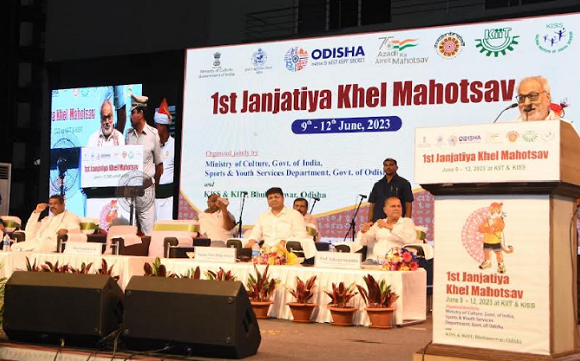8 day long Rath Yatra in Biraja temple kicked off without devotees
By Akshya Rout
Jajpur , Octo 8 : The 8day long famous Rath Yatra in the Ma Biraja temple in Jajpur town was kicked off under the shadow of a raging Covid 19 pandemic on Thursday. The entire Temple area was under Section 144 of the CrPC and a curfew-like situation prevailed in the Biraja Khetra.
All entry points and roads leading to the temple were barricaded and sealed by the district administration and debarred devotees to attend the Rath Yatra as a result when the chariot rolled around the temple for the first time without any participation of devotees. The 60 feet long chariot was pulled by servitors only with the presence of police.
All the servitors had been tested for Covid-19 and allowed to take part only on being found negative,All the priests and other participants followed the proper precautions like use of sanitizer, masks and social distancing to stay safe during the Rath Yatra, said Chakravarti Singh Rathore the collector of Jajpur.
Previous year Orissa High Court on 8th October allowed Biraja Rath Yatra after hearing Public Interest Litigations(PILs) and directed the district administration to conduct the rath yatra by adhering to the covid-19 guidelines As per the order of the High Court the district administration allowed the Rath Yatra by considering the religious sentiments and keeping the the long traditions of the festival with some restrictions due to coronavirus , added the collector.
Columnist Er Taraprasad mishra said Ratha tradition is too old in our civilization. Even we can find in the Rig Veda about the Ratha Jatra. Ratha is the only medium to travel. God sun travels in the morning and makes everyone active.
The famous two epics of India, The Ramayana and the Mahabharata give vivid accounts of the uses of Ratha by Raja, Maharaja, Deva, Danaba. In the Indian literature descriptions about Atma Ratha, Yoga Ratha, Vishnu Ratha, Sakti Ratha, Surya Ratha, Kandarpa Ratha, Nrupa Ratha have been beautifully described. Ratha Jatra celebrated in the Srikshetra, Puri is popularly known as Ghosha Jatra or Gunddicha Jatra.
This festival happens in the Asadhashukla 2nd paksha every year in where lord Jagannatha travels from the Srimandira to Mausimaa temple for nine days. It is not only celebrated in Puri but other cultural regions of Odisha. Many different shrines across Odisha have their own chariot-pulling festivals. Bhubaneswar’s famous Lingaraja Temple’s Rukuna Ratha Jatra on Ashokastami, Konarka’s Surya Ratha Jatra on Magha.
Odisha is said to be the place from which the Tantra culture started. So it is clear that it has many Shakti peethas. But the Goddess Biraja has a special significance. Even there is a greater similarity found between Jagannatha mandala and Biraja mandala.
Like Jagannatha-panjika, Biraja-panjika also regulates auspicious, inauspicious date & rules for its region. We can trace her presence in various Puranas and also in the two epics of the Mahabharata and the Ramayana. Unique to the core, this festival (Ratha Jatra) of Goddess Biraja is iconic in itself, as she is the only Goddess in Odisha to have her own chariot festival.
It was in 13th century that this amazing temple of Biraja got established by Somavamsi king. Chandihar Jajati-II at present Jajpur. According to the temple lore, when Shiva performed Tandavanrutya by carrying the corpse of Devi Sati, her remains got scattered in different places due to the strike of Sudarshan Chakra by Vishnu, which later came to be known as Shakti Peethas.
And interestingly, Biraja is also one such divine peetha (according to the Tantra Chudamani, Sati’s navel fell in the Utkala Kingdom). However, as per another legend, Lord Brahma performed a yajna on the bank of the river Baitarani from which Goddess Parvati emerged.
The Goddess then instructed Lord Brahma to name her as Biraja, after which she occupied her position at the circumcenter of the triangular region in Jajpur. So it is a great Shakti Peetha in Odisha. Here the Dwibhuja-Durga idol spearing the chest of Mahishasura with one hand and pulling his tail with the other. One of her feet is on a lion, and the other is on Mahishasura’s chest.
Mahishasura is depicted as a water buffalo. The idol’s crown features Ganesha, a crescent moon and a Shiva linga. Here She is worshiped daily in accordance with Tantra and Agama traditions as Mahishasuramardini. The Somavamsis added Ratha Jatra with the Biraja tradition like that of the Goddess Vindhyabasini and Sthambheswari of mid-India.
It is during the Aswina month that Goddess Biraja sets out for her nine day sojourn around the Mandira bedha (boundary wall of the shrine) on her chariot known as Singhadwaja (flag bearing a lion) or Bijaya Ratha.
People from different communities and castes gather to partake in this exclusive festival and catch a glimpse of this Goddess! And on Bhadrab Shukla Dwadashi (sunia), starts the Banajaga Jatra or the onset of procession to find trees for building the chariot and the procession called ‘Bilwa Barana’. After the wood is collected and the chariot is built, a consecration ceremony is undertaken on the Pratistha Mandap during Mulashtami.
It is impossible for main idol of Goddess Biraja to come out from the temple sanctum for Ratha Jatra. So a metal idol of her acts as her representative (Chalanti-Pratima) and the representative deity is then carried out onto the chariot, parked in front of the Lion Gate.
On the ninth day of her sojourn, Aparajitapooja is performed and thereafter the Goddess kills the buffalo demon, Mahisasura. It is then that Goddess Biraja returns to her abode, hence marking the end of her sacred journey.






